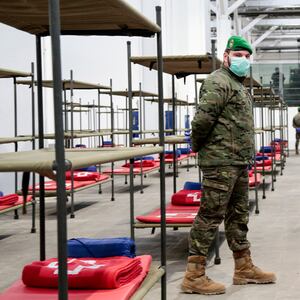LA CORUNA, Spain—Spain is one huge sunny terrace, a seaside hotel with a load of historic buildings and unparalleled museums. The country of a thousand selfies raising a beer to the blue sky. The same can be said of France. Before the pandemic, they were the two most visited destinations in the world. That said, tourism involves crowds, long journeys, large hospitality spaces, and generally everything that increases the chances of contagion in the event of a pandemic.
Now, the industry has collapsed and generates barely half of what it did a few years ago. And, as if that were not enough, the European Centre for Disease Prevention and Control has just advised against travel to most EU states, due to the spread of the new, ultra-mutated Omicron variant, seven cases of which have been identified in Spain so far. For the moment, Spain, with very low levels of contagion and roughly 80 percent of its population vaccinated, is still in the clear.
Mediterranean Europe dared to dream of a summer of recovery for 2021, and although the figures have improved, they’re nowhere near what they were in 2019. Spain, France, Italy, Greece, and Portugal are anxiously awaiting the resurrection of international tourism. In many cases, including in Spain, the extreme dependence on tourism has made it virtually the only hope of economic recovery post-pandemic.
ADVERTISEMENT
To put it into perspective: in 2019, tourism made up for 12.4 percent of Spain's GDP. This year, the tourism industry is accounting for half of that.
Alexandre Fratini is the owner of the restaurant Pinocchio in Benidorm, on the east coast of Spain, and a member of the board of directors of the association of hoteliers, ABRECA. “Destinations like Benidorm have been the hardest hit by the pandemic, because we live exclusively from tourism,” he explains to The Daily Beast. “In cities like Alicante, the drop in turnover has been 25 percent whereas in Benidorm the drop has been as much as 85 percent. The lack of tourists has led to many businesses closing down.”
Nuria Montes, general secretary of the Valencian hotel association HOSBEC, paints a bleak picture as she recalls what the sector has been through. “In March 2020, we started the year with almost no activity. Only in the summer, about 50 percent of the hotels were able to open, but afterwards almost all of them closed again. From October 2020, Valencia was sealed off around the perimeter, preventing tourists from entering the city until May 9, 2021. This was a devastating period: 90 percent of the hotel offering was closed."
She concluded: “Although the situation has been gradually returning to normalcy,” as of August, “between 20 and 30 percent of the hotels in the Valencian Community were still closed."
The economies of France and Italy have done better during the pandemic. According to the balance of payments from the European Central Bank, the losses of both countries combined do not exceed what Spain lost between January and September 2020. The explanation is simple: Spain focuses on selling tourists its so-called sun and beach model, so most of the visits take place in spring and summer, precisely the time when the greatest restrictions were imposed in 2020. France and Italy’s visitors are more staggered throughout the year, which helped them make up for the international tourism crisis.
Although Spain is the third country in the world with the most UNESCO World Heritage Sites, surpassed only by Italy and China, none of them are among the 20 most visited. Analysts agree that tourists who come to Spain are interested in sun and beach. It is quite astounding that this should be so, in a country that is home to the Cathedral of Santiago de Compostela, the Alhambra in Granada, and the Prado Museum in Madrid. The truth is that many decades ago, the Spaniards bet everything on that tourist card that has placed the country in its present predicament.
With only 50 percent of their pre-pandemic turnover in 2020, Spanish travel agencies, tour operators, hotels and catering services have had to place many of their workers in Temporary Redundancy Proceedings, an authorization that exempts them from paying workers, who are instead a portion of their salaries by the government. Italy and France have also opted for a system of partial unemployment with compensation of up to 70 percent of the workers’ previous gross salary. A significant number of these laborers have been rejoining the workforce, but things are still not back to how they were pre-pandemic and tourist-reliant businesses are still oversized.
“In 20 months of the pandemic,” Montes told The Daily Beast, “the tourism sector has received totally residual public aid. The government should extend the system of Temporary Employment Regulation Files, and activate direct aid to improve cash flow, and launch a plan to stimulate tourism demand.”
Fratini, the restaurant owner, agrees. “Since the beginning of the pandemic we have been calling for compensation for the losses generated by the mandatory closures, the reduced capacity, the shortened opening hours and the lack of tourists. The autonomous and central governments should inject liquidity into the sector, modernizing it without resorting to loans,” he said.
It reached the point where social aid was needed to avoid leaving thousands of families and companies destitute, but the underlying problem remains unsolved. We are now hearing voices that are evermore critical of economies that are overly dependent on tourism, especially in Spain, which is more dependent on tourism than the rest. But changing an entire economic model is not something that can be done in a few months.
Seen in context, it was reasonable for these countries to bet on leisure-seeking travelers. Mediterranean tourism has been steadily growing since 1995, with the sole exceptions of the financial crisis of 2009 and the internal instability of Turkey and Egypt in 2016. No one could have foreseen then that a virus would erupt, bringing everything to a standstill. The full stop has left workers, entrepreneurs and governments unsettled, surrounded by a trail of bankruptcies and ruin, and with huge masses of the workforce dependent on aid packages.
Though the country is still open to tourists, the new variant has many in the industry concerned that the coming weeks could bring them back to square one.
"The next few weeks are decisive to know how the new strain will be dealt with if the vaccines are effective,” says Montes, “and if it is going to take further restrictive measures that could impact tourism.”
There is, however, some light at the end of the tunnel. Data recently published by SiteMinder’s World Hotel Index shows that in 2021, Madrid and Barcelona have surpassed their level of visitors prior to the pandemic, ahead of other European cities such as Paris, London, Amsterdam and Berlin.
The case of Madrid is paradigmatic. From the beginning of the pandemic, its regional government led a different strategy to all the major European cities, opting to impose as few restrictions as possible, leaving those decisions completely in the hands of health experts without political interference. Today, it can boast of having recovered almost all the national tourism it had before the health crisis and, as explained by the regional government, the objective is now to promote tourism from America and Southeast Asia.
If there is hope it is because, after all we have been through, the beaches of the Mediterranean, the Camino de Santiago, the Greek islands, Seville, Rome, and the “Portuguese Rome”—Braga—are still standing in all their splendor, just as radiant as ever.









